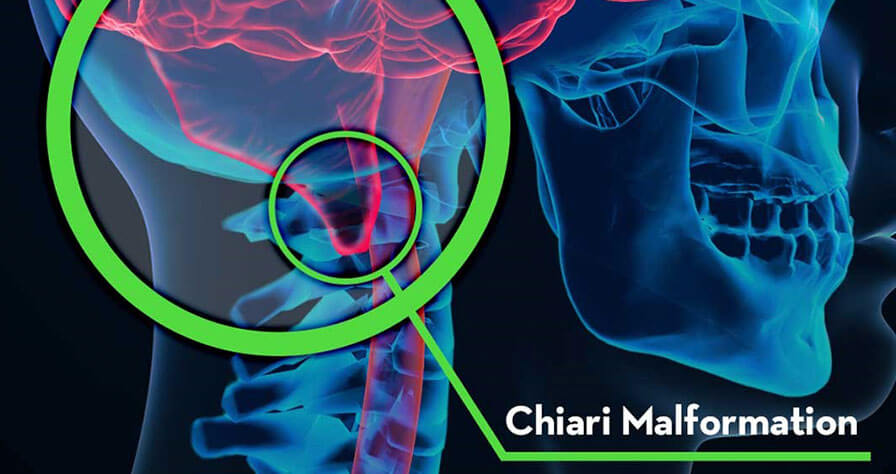Understanding Chiari Malformation

Chiari malformation is a structural deformity in the base of the skull and cerebellum. The cerebellum is the part of the brain that regulates muscular activity, including balance and fine motor skills. Normally, the cerebellum and some parts of the brain stem sit above an opening in the skull where the spinal cord is supposed to pass through. When a Chiari malformation is present, the cerebellum is forced through that opening (called the foramen magnum). This puts pressure on the cerebellum and brain stem, which can affect the bodily functions controlled by those two parts of the brain. It can also block the flow of cerebrospinal fluid (CSF). CSF surrounds and cushions the brain and spinal cord. It also supplies nutrients to and removes waste from the brain.
Causes of Chiari Malformation
In most cases, Chiari malformation is congenital, meaning issues occur during fetal development. It may be a result of genetic mutation or lack of essential nutrients in the mother’s diet. Congenital Chiari malformation may also be referred to as primary Chiari malformation.
Secondary Chiari malformation, on the other hand, develops later in life and can be caused by a traumatic injury, disease or infection. This type of Chiari malformation is much less common than primary Chiari malformation.
Symptoms of Chiari Malformation
The primary symptom of Chiari malformation is a headache. Other symptoms include:
Neck pain
Hearing and balance problems
Weakness or numbness
Difficulty swallowing or speaking
Vomiting
Tinnitus (ringing in the ears)
Scoliosis (curvature of the spine)
Insomnia
Depression
Poor hand-eye coordination
Problems with fine motor skills
In infants with Chiari malformation, parents may notice irritability during feeding, excessive drooling, breathing problems, difficulty gaining weight and developmental delays.
Types of Chiari Malformation
There are four types of Chiari malformation — I, II, III, and IV.
Type I
The most common and least severe form of Chiari malformation, Type I may not cause any symptoms. It’s usually discovered unexpectedly in adolescents and adults when examining, diagnosing, or treating another condition. Those who have Chiari malformation Type I without initial symptoms may develop complications later in life.
Type II
Symptoms of Chiari malformation Type II usually appear during childhood. Type II is much more serious than Type I and can be life-threatening. Surgery is required to treat the condition. In nearly all instances, Chiari malformation Type II is accompanied by myelomeningocele, a form of spina bifida, which is caused by developmental problems of the spinal cord and backbone. Hydrocephalus and scoliosis are also associated with Chiari malformation Type II.
Type III
Very rare and very serious, Chiari malformation Type III is a congenital condition in newborns and results in part of the cerebellum and brainstem stick out through an abnormal opening in the skull. Infants born with Type III typically do not live long. Those who do will likely suffer from severe neurological complications, including mental impairment, intellectual disabilities, seizures, and poor muscle control.
Type IV
This form of Chiari malformation is exceedingly rare and almost always results in death. In Type IV, parts of the cerebellum are missing and the spinal cord may have developed outside the body. Like Type III, this is a condition seen only in infants.
Chiari Malformation Treatment
Treatment for Chiari malformation, provided by a neurosurgeon, depends on the type. In cases with no or mild symptoms, it may be enough to “wait and see,” monitoring the condition with regular MRI scans.
If symptoms do present (or if a patient doesn’t want to undergo surgery), medications, physical therapy and lifestyle changes may help alleviate side effects of Chiari malformation.
Surgery may be required to treat more severe Chiari malformation. Neurosurgeons can perform a surgery called posterior fossa decompression, which creates more space for the cerebellum and relieves pressure on the spinal cord. More than one surgery may be need to treat the condition.
Need More Information?
Speak with a doctor or find a neurosurgeon. Only a healthcare provider can diagnose and treat Chiari malformation.




.jpg?rev=f59f3f2e0f3f487b8eb5863dcf9df0c2)